Vaccine Technologies Market Research, 2033
The global vaccine technologies market size was valued at $48.5 billion in 2023, and is projected to reach $90.6 billion by 2033, growing at a CAGR of 6.4% from 2024 to 2033. Growth of the vaccine technologies market is driven by advancements in biotechnology, increased global vaccination campaigns, rise in awareness about preventive healthcare, and need for rapid vaccine development in response to emerging infectious diseases. For instance, according to the World Health Organization (WHO), in January 2023, a total of 64 infectious diseases were reported globally, affecting 235 countries and regions. In addition, WHO estimated that more than 25 million outpatient visits and more than 2 million hospitalizations were attributable to rotavirus infections each year.
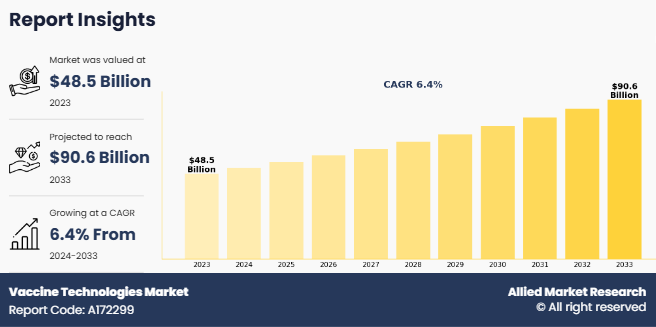
Vaccine technologies have advanced significantly, with several innovative platforms improving vaccine development. Traditional inactivated and live-attenuated vaccines remain crucial, while newer technologies like mRNA vaccines, viral vector vaccines, and protein subunit vaccines offer faster, more precise approaches. For instance, mRNA vaccines use messenger RNA to instruct cells to produce antigens, prompting an immune response. Viral vector vaccines use modified viruses to deliver genetic material, and protein subunit vaccines focus on delivering specific antigenic proteins. These technologies are improving vaccine safety, efficacy, and accessibility, especially for emerging diseases and pandemics.
Key Takeaways
- By technology, the recombinant, conjugate and subunit vaccine segment was the largest contributor to the vaccine technologies market size in 2023 and is expected to maintain its dominance during the forecast period
- By delivery method, the parenteral segment dominated the market share in 2023. However, the oral segment is expected to register the highest CAGR during the forecast period.
- By type, the multivalent vaccines segment was the largest contributor to the market in 2023 and is expected to maintain its dominance during the forecast period.
- By region, North America was the largest contributor to the market in 2023. However, Asia-Pacific is expected to register the highest CAGR during the forecast period.
Market Dynamics
The vaccine technologies market growth is driven by rising prevalence of infectious diseases, technological advancements, favorable initiatives by government and private organizations and increasing focus on preventive healthcare. Diseases such as influenza, tuberculosis, human papillomavirus (HPV), and hepatitis continue to pose significant public health challenges worldwide, leading to increased demand for effective prevention strategies. According to the World Health Organization, in 2023, an estimated 10.8 million people were diagnosed with TB globally. The global prevalence of infectious diseases has led to substantial investments in vaccine research and development, including the adoption of cutting-edge technologies such as mRNA platforms, viral vector systems, and recombinant protein-based vaccines.
Furthermore, technological advancements have significantly propelled the vaccine technologies market by enhancing vaccine development, production, and delivery. Innovations such as next-generation sequencing, recombinant DNA technology, and mRNA platforms have revolutionized the creation of safer and more effective vaccines. According to a 2022 article by the National Library of Medicine, nucleoside modification and lipid nanoparticle-facilitated delivery has greatly improved the immunogenicity, stability, and translation efficiency of mRNA molecules. These technologies allow for precise targeting of pathogens and faster development timelines, enabling responses to emerging health threats. In addition, advancements in adjuvant systems have improved vaccine efficacy by enhancing immune responses. Thus, advancement in the vaccine technology is expected to significantly contribute to the vaccine technologies market growth.
In addition, favorable initiatives by government and private organizations significantly drive the growth of the vaccine technologies market. Governments globally prioritize immunization programs, providing substantial funding, subsidies, and grants to develop and distribute advanced vaccines. For instance, under the Universal Immunization Programme, the Government of India is providing vaccination to prevent eleven vaccine-preventable diseases i.e. Diphtheria, Pertussis, Tetanus, Polio, Measles, Rubella, severe form of Childhood Tuberculosis, Hepatitis B, Haemophilus Influenza type B (Hib), Pneumococcal and Diarrhoeas due to Rota virus. These initiatives aim to combat infectious diseases and improve global health outcomes.
In addition, private organizations, including non-profit entities and pharmaceutical companies, actively contribute through collaborations, partnerships, and investments to advance vaccine research and development. For instance, in December 2024, International AIDS Vaccine Initiative (IAVI), and Institut Pasteur Dakar (IPD) have signed an agreement to formally collaborate for vaccine development, manufacturing, and access in Africa. With the signing of this agreement, IAVI and IPD are establishing a collaboration to research, develop, manufacture, and commercialize a range of novel vaccine candidates for both endemic and emerging infectious disease (EID) threats – all manufactured using a common vaccine production platform. Programs focused on improving vaccine access in low- and middle-income countries, along with public-private partnerships, further enhance the market's growth by fostering innovation and ensuring equitable distribution. The collaborative efforts by government and private organization are expected to provide vaccine technologies market opportunity.
Segmental Overview
The vaccine technologies market is segmented on the basis of technology, delivery method, type, and region. By technology, the market is classified into live attenuated vaccines, inactivated vaccines, recombinant, conjugate and subunit vaccines, toxoid vaccines, and others. By delivery method, it is segregated into parenteral, oral, and nasal. By type, the market is divided into monovalent vaccines and multivalent vaccines. Region-wise, the market is analyzed across North America, Europe, Asia-Pacific, and LAMEA.
By Technology
The recombinant, conjugate and subunit vaccine segment held the largest vaccine technologies market share in 2023. This was attributed to its ability to provide high efficacy, safety, and specificity. Recombinant vaccines utilize advanced genetic engineering techniques to produce antigens, enhancing their effectiveness in stimulating a robust immune response while minimizing adverse effects. Conjugate vaccines, which link antigens to carrier proteins, have proven highly effective in immunizing against bacterial infections like Haemophilus influenzae type B (Hib) and Streptococcus pneumoniae, particularly in children and immunocompromised individuals. Subunit vaccines, which use purified antigenic components rather than whole pathogens, further reduce the risk of side effects while maintaining strong immunogenicity. In addition, scalability of these technologies for mass production and their suitability for diverse pathogens have driven their widespread adoption in global immunization programs
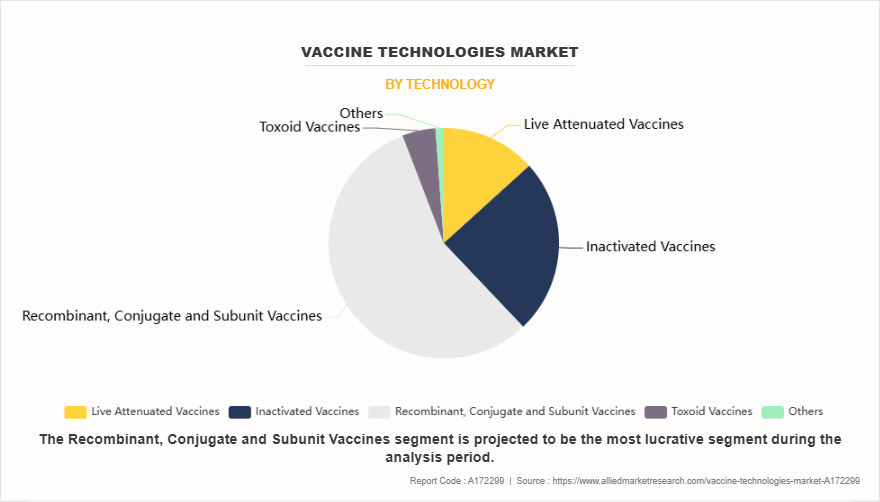
By Delivery Method
By delivery method, the parenteral segment held the largest vaccine technologies market share in 2023. This is attributed to its efficiency in delivering vaccines directly into the bloodstream or muscle, ensuring rapid and robust immune responses. This method bypasses the digestive system, preventing degradation of vaccine components and maximizing their efficacy. Parenteral delivery is widely preferred for its proven effectiveness across various vaccine types, including those for influenza, hepatitis, and meningitis.
In addition, advancements in needle and syringe technology, as well as the development of prefilled syringes, have enhanced safety, convenience, and compliance, further boosting its adoption. The availability of skilled healthcare professionals to administer parenteral vaccines and the widespread integration of this delivery method into routine immunization programs also contribute to its adoption. However, the oral segment is expected to register the highest CAGR during the vaccine technologies market forecast period. This is attributed to its non-invasive nature, which significantly enhances patient compliance and acceptance.
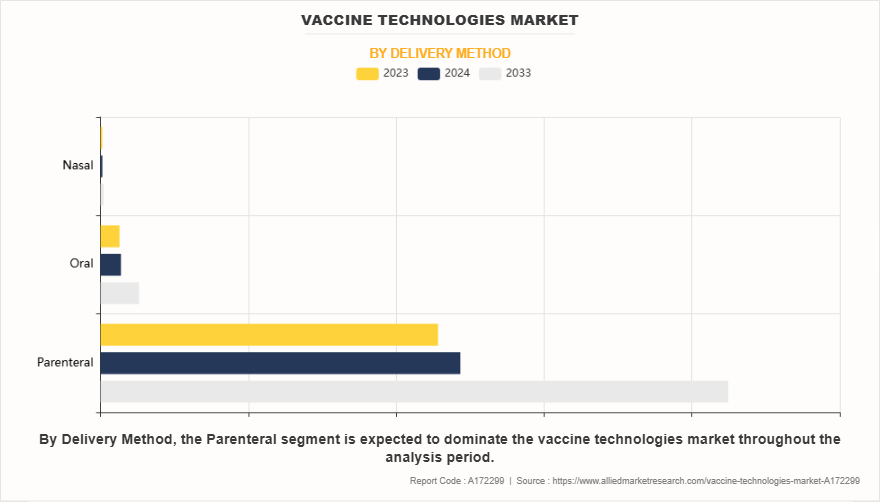
By Type
The multivalent vaccine segment held the largest share of the market in 2023. This is attributed to their ability to target multiple strains or pathogens in a single formulation, providing broader protection and reducing the need for multiple vaccinations. Multivalent vaccines are particularly valued for their efficiency in addressing diseases caused by pathogens with high genetic variability, such as influenza or human papillomavirus (HPV). Moreover, their convenience in immunization programs has driven widespread adoption, as they minimize the logistical challenges associated with administering multiple doses while improving patient compliance. The increasing prevalence of infectious diseases, coupled with advancements in vaccine technology enabling the development of effective multivalent formulations, has further fueled the demand for these vaccines.
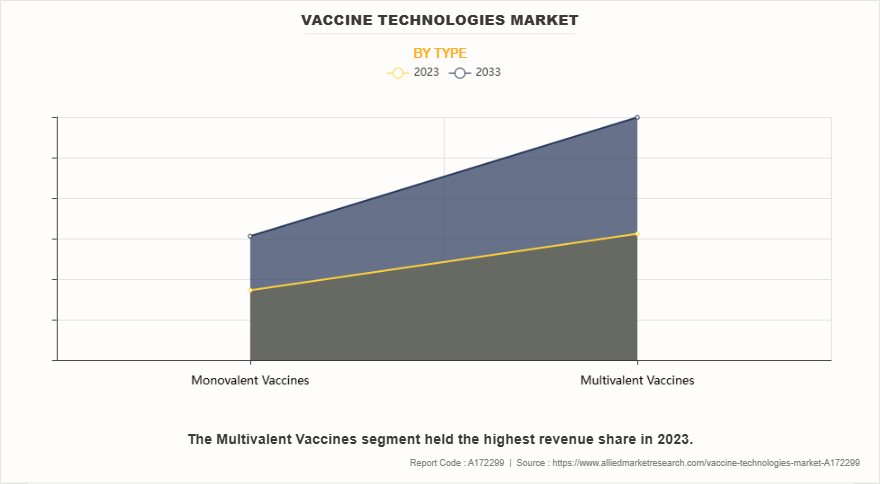
By Region
North America has emerged as a major revenue generator in the vaccine technologies market due to several factors, including robust healthcare infrastructure, significant government investments in vaccine research and development, and a high rate of vaccination programs. The presence of leading pharmaceutical companies and biotechnology firms in the region, coupled with advanced manufacturing capabilities, has further driven innovation and production efficiency. Additionally, strong regulatory support and initiatives aimed at increasing vaccine coverage have boosted market growth in North America. However, the Asia Pacific region is anticipated to register the highest CAGR during the forecast period, driven by a growing population, rising awareness of immunization, and increasing government initiatives to improve healthcare access. The region is witnessing rapid economic growth, which has led to increased healthcare expenditure and the expansion of vaccine production facilities.
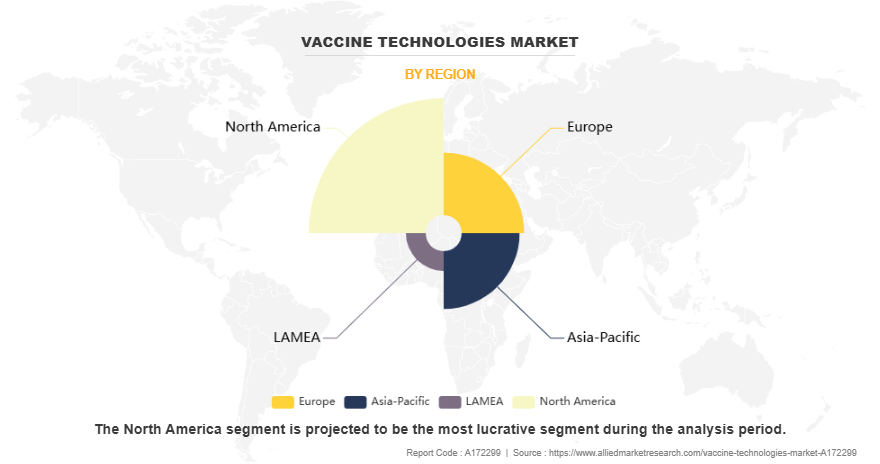
Competition Analysis
The major companies profiled in the vaccine technologies industry report include Sanofi, Pfizer Inc., Emergent BioSolutions Inc, AstraZeneca, CSL Limited, Sinovac Biotech Ltd., Bavarian Nordic, Chongqing Zhifei Biological Products Co., Ltd., Merck & Co. Inc., GSK plc. and Bharat Biotech International Limited.
Recent Developments in Vaccine Technologies Industry
In December 2024, Emergent BioSolutions Inc. announced that the Biomedical Advanced Research and Development Authority (BARDA) has awarded a $50 million option to Emergent’s existing contract for the acquisition of CYFENDUS (Anthrax Vaccine Adsorbed, Adjuvanted)
In October 2024, Pfizer Inc. announced that the U.S. Food and Drug Administration (FDA) approved ABRYSVO (Respiratory Syncytial Virus Vaccine), the company’s bivalent RSV prefusion F vaccine, for the prevention of lower respiratory tract disease (LRTD) caused by RSV in individuals 18 through 59 years of age who are at increased risk for LRTD caused by RSV.
In March 2024, Pfizer Inc. announced that the European Commission (EC) has granted marketing authorization for the company’s 20-valent pneumococcal conjugate vaccine, marketed in the European Union under the brand name PREVENAR 20, for active immunization for the prevention of invasive disease, pneumonia and acute otitis media caused by Streptococcus pneumoniae in infants, children and adolescents from 6 weeks to less than 18 years of age.
In March 2024, Bavarian Nordic A/S announced that the Swiss Agency for Therapeutic Products, Swissmedic, approved JYNNEOS (MVA-BN) for active immunization against disease caused by smallpox, mpox and vaccinia viruses in adults 18 years of age and older.
Key Benefits for Stakeholders
- This report provides a quantitative analysis of the market segments, current trends, estimations, and dynamics of the vaccine technologies market analysis from 2023 to 2033 to identify the prevailing vaccine technologies market opportunities.
- The market research is offered along with information related to key drivers, restraints, and opportunities.
- Porter's five forces analysis highlights the potency of buyers and suppliers to enable stakeholders make profit-oriented business decisions and strengthen their supplier-buyer network.
- In-depth analysis of the vaccine technologies market segmentation assists to determine the prevailing market opportunities.
- Major countries in each region are mapped according to their revenue contribution to the global market.
- Market player positioning facilitates benchmarking and provides a clear understanding of the present position of the market players.
- The report includes the analysis of the regional as well as global vaccine technologies market trends, key players, market segments, application areas, and market growth strategies.
Vaccine Technologies Market Report Highlights
| Aspects | Details |
| Market Size By 2033 | USD 90.6 billion |
| Growth Rate | CAGR of 6.4% |
| Forecast period | 2023 - 2033 |
| Report Pages | 348 |
| By Technology |
|
| By Delivery Method |
|
| By Type |
|
| By Region |
|
| Key Market Players | Pfizer Inc., Chongqing Zhifei Biological Products Co., Ltd., Emergent BioSolutions Inc., Sinovac Biotech Ltd, CSL Limited, Merck & Co Inc, Bharat Biotech International Limited, Sanofi, Bavarian Nordic, AstraZeneca, GSK plc. |
Analyst Review
The vaccine technologies market is experiencing a dynamic shift, driven by advancements in research and technology. There is a significant focus on innovation and efficiency in vaccine development, particularly with the integration of novel platforms such as viral vector, and DNA vaccines. These technologies are enabling faster, more targeted responses to emerging infectious diseases, positioning companies to better address global health challenges. Rise in prevalence of infectious diseases, rise in demand for vaccine programs in both developed and emerging markets, and increased adoption of advanced manufacturing techniques are contributing to the market growth. As global health systems continue to face pressure to manage pandemics, chronic diseases, and preventable infections,
investments in research and development (R&D) are critical. Rise in digital health tools, including vaccine tracking and management platforms, is also reshaping the market, allowing for more effective distribution and monitoring of vaccine coverage.
North America generated the largest revenue in 2023, owing to advancements in healthcare infrastructure, high rate of vaccine adoption, and robust government support for immunization programs. These factors have driven the demand for innovative vaccine technologies in the region. In addition, strong presence of leading pharmaceutical companies and research institutions has further bolstered the market growth. However, Asia-Pacific is expected to register the highest CAGR during the forecast period, owing to the expanding healthcare infrastructure, increasing government initiatives for vaccination programs, and rise in awareness about preventive healthcare. The region's large population and rise in demand for cost-effective vaccine solutions also contribute to the market growth.
The total market value of vaccine technologies market was $48.5 billion in 2023.
The forecast period for vaccine technologies market is 2024 to 2033.
The market value of vaccine technologies market is projected to reach $90.6 billion by 2033.
The base year is 2023 in vaccine technologies market.
North America is accounted for the largest market share in 2023 owing to well established healthcare infrastructure, rise in investments in research and development, and the easy availability of vaccines.
The major key players such as Merck & Co Inc., GSK plc., Sanofi , Pfizer Inc., and CSL Limited held high market position in 2023.
Advances in biotechnology, increasing demand for personalized vaccines, and rising prevalence of infectious diseases and chronic conditions drive market growth.
Vaccines are biological substances designed to stimulate the body's immune system to recognize and fight against specific pathogens, such as viruses or bacteria, without causing the disease itself.
Vaccinations play a key role in sustaining people's health across different countries; hence, they are used in various national disease-prevention strategies
Loading Table Of Content...
Loading Research Methodology...



